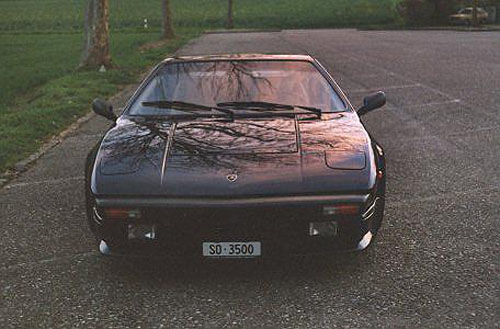|
The Jalpa was the successor to the Lamborghini Silhouette, a Bertone
designed evolution of the Silhouette bodywork.
On the 1981 Geneva Auto Show a prototype was shown with a rear spoiler
installed but it wasn't installed on the actual production types. The
dashboard used a new kind of box-shaped instrumentation, on the early
Jalpa's a steering wheel similar to the Silhouette's was used, later
a bigger, triangular shaped one was installed. New seats were used for
the Jalpa, now with fully adjustable backrests.
On the whole the Jalpa may look less spectacular than the angular Silhouette,
but it still looked stunning.
The early production cars used black bumpers to the front and the rear,
the side air intakes for the engine were also finished in black, at the
rear the taillights from the Silhouette were used.
The 3.0-Litre engine from the Silhouette and the Urraco P300 was enlarged
to a 75mm stroke resulting in a 3485 cc displacement and pumped out 255
bhp at 7000 rpm, the Jalpa also used 16 inch wheels instead of the earlier
15-inch units on the Silhouette.
The Jalpa name was taken from a famous breed of fighting bulls, and
it was very easy to drive, even in city traffic. However it had a few
faults, the seating position wasn't perfect and the windscreen provided
some distracting reflections at night, even the vertical rear window
suffered from this problem through the rear view mirror, and the front
lights were hardly adequate. The Jalpa became Lamborghini's most successfull
V-8 to date, when its production was halted in July 1988, it had sold
416 units, partly because this Lamborghini, unlike the Silhouette, was
again officially certified for sale in the United States. On the 1984 Geneva Auto Show a few changes were presented, the black
plastic body parts were now finished in the body color and the tail
lights became circular like on a Ferrari.
The Jalpa could become unreliable, just like any other Lamborghini or
exotic car for that matter, when it wasn't regularly and competently
serviced, in terms of pure performance, the Jalpa was as good as the
rest but in terms of irresistibility it was at the top of the pile.
The Jalpa was known as the Baby-Lambo, the other Lamborghini next to
the space-age Countach, but the Jalpa was just as exotic and rare, perhaps
even more, because it was built in smaller numbers, everybody recognised
the Countach, but the Jalpa was far less well known. The Jalpa was fully
capable to be driven in the city, the V-8 was just as lovely to listen
to as the V-12 and the steel bodywork by Silver Car of Turin was very
sensuous to look at. But during 1987 sales dropped for this beauty and
Chrysler, by then owner of Automobili Lamborghini SpA, decided the Jalpa
wasn't the car needed next to the Countach and halted 1988 its production.
But a successor is being designed, it will use a V-10 engine and is
called the P-140. 
Today the Jalpa is regarded as a more 'affordable' Lamborghini, but
the used car prices are still around $50.000 for a good car, while $54.000
was its list price.
Several Jalpa's were equiped with rare Silhouette-style wheels and some
even installed a Countach-type rear wing on it.
A few Jalpa's were seen with side mouldings connecting the front and rear
wheelarch extensions, most of these were modified in Germany or Switzerland.
|

![]()




